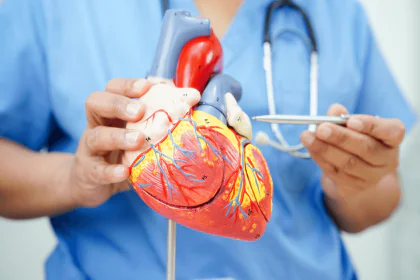Picture this: your heart, a tireless maestro, orchestrating the rhythmic symphony of life-giving blood.
As this vital fluid dances through your veins, it delivers oxygen and nutrients to every corner of your being, keeping you energized, healthy, and ready to take on the world.
But sometimes, this delicate balance can be disrupted, leaving you feeling sluggish, cold, and out of sync.
That’s where exercise comes in, the secret conductor to your circulatory orchestra.
By incorporating these simple yet effective exercises into your daily routine, you can awaken your inner energizer, rev up your circulation, and feel the revitalizing flow of life coursing through your veins.
The smooth flow of blood, known as circulation, plays a crucial role in maintaining optimal health.
It facilitates the efficient delivery of oxygen to every corner of the body and aids in the elimination of waste.
However, the majority of us don’t ponder on our circulation until it becomes problematic.
Yet, when you contemplate its role, it’s truly remarkable.
According to the British Heart Foundation, our hearts tirelessly beat approximately 100,000 times each day, propelling around five liters of blood throughout our bodies via the circulatory system (i).
This intricate network, also known as the vascular system, encompasses various blood vessels, including arteries and capillaries, that intricately reach every part of the body, along with veins.
If your circulation isn’t up to par for any reason, it can manifest in a range of symptoms such as:
- Cold hands and feet, even in warmer weather
- Changes in skin color
- Numbness in specific body parts, especially extremities
- Lack of energy
- Difficulty focusing and concentrating
- Memory issues
- Dizziness
- Headaches
- Pins and needles sensation
- Muscle cramps
- Dry skin
- Swelling, particularly in the feet or ankles (oedema)
- Digestive problems
Meanwhile, several factors may contribute to the development of poor circulation.
Age and overall health, familial predisposition, excess weight, and smoking are all associated with circulatory issues.
Certain medical conditions can also lead to poor circulation:
Atherosclerosis:
Caused by the accumulation of fatty substances like cholesterol, atherosclerosis results in the hardening and narrowing of arteries, impeding effective blood flow.
If untreated, it escalates the risk of cardiovascular diseases, including angina, heart attack, stroke, coronary heart disease, and peripheral arterial disease.
Peripheral Artery Disease (PAD):
Atherosclerosis restricting blood supply to leg muscles, often causing pain during walking.
Raynaud’s Phenomenon:
This condition obstructs blood supply to extremities, turning parts of the body, typically fingers and toes, white, blue, purple, and sometimes black.
It may cause pain, tingling, throbbing, and numbness.
Diabetes:
Persistent high blood sugar can damage blood vessels, adversely affecting circulation.
Blood Clots:
Clots in blood vessels can limit or completely block circulation, potentially leading to serious conditions such as heart attack, stroke, and pulmonary embolism (where a clot obstructs a blood vessel in the lungs).
When circulation falters, characterized by sluggish blood flow, it can manifest in symptoms like fatigue, heaviness in the legs, cold extremities, low energy levels, and lackluster skin.
Is Exercise Beneficial?
Being inactive is believed to be a significant contributor to poor circulation.
The positive aspect is that you can mitigate circulation issues by engaging in regular exercise and increasing overall physical activity.
Any form of movement is beneficial for maintaining a robust, flexible, and healthy circulatory system, effectively supporting your heart and, coincidentally, enhancing workout performance.
This is due to the increased oxygen volume in the blood reaching your muscle tissue during exercise.
Fortunately, a simple remedy to enhance circulation is through regular exercise.
Engaging in activities that get your heart pumping will not only invigorate your body but also infuse you with an extra dose of vitality.
So, let’s lace up those sneakers and dive into 10 effective exercises that will get your blood pumping and leave you feeling invigorated.
1. Brisk Walking:
Step out into the great outdoors or hop on a treadmill for a brisk walk.
It’s a simple yet powerful way to boost circulation, and you can easily incorporate it into your daily routine.
2. Jumping Jacks:
Remember those fun-filled days of jumping jacks in gym class? Well, they’re not just for kids!
Jumping jacks are a fantastic cardiovascular exercise that gets your heart racing and your blood flowing.
3. Cycling:
Whether you prefer the open road or a stationary bike at the gym.
Cycling is an excellent way to improve circulation.
It engages multiple muscle groups and promotes healthy blood flow throughout the body.
4. Swimming:
Take a dip and enjoy the many benefits of swimming.
The buoyancy of the water reduces stress on joints while the rhythmic movements enhance circulation.
It’s a full-body workout that’s easy on the joints.
5. Yoga:
Embrace the gentle yet powerful world of yoga.
Poses like downward dog, child’s pose, and the warrior series can help improve circulation by encouraging blood flow and flexibility.
6. Strength Training:
Lifting weights not only builds muscle but also enhances circulation.
Engage in strength training exercises like squats, lunges, and push-ups to boost blood flow and improve overall cardiovascular health.
7. Dancing:
Turn up the music and dance like nobody’s watching! Dancing is a fun and effective way to get your heart pumping, improve circulation, and lift your spirits.
8. High-Intensity Interval Training (HIIT):
Short bursts of intense exercise followed by brief rest periods define HIIT.
This approach not only improves cardiovascular health but also stimulates blood circulation, making it a time-efficient workout option.
9. Leg Raises:
Sit or lie down and lift those legs! Leg raises help activate your leg muscles, promoting blood flow and preventing issues like varicose veins.
10. Tai Chi:
Explore the graceful movements of Tai Chi, a low-impact exercise that enhances circulation while promoting relaxation and balance.
It’s a mindful approach to improving overall well-being.
The importance of blood circulation and how it affects overall health and well-being.
The significance of blood circulation for holistic well-being is paramount.
Efficient blood flow plays a crucial role in sustaining overall health, influencing various aspects of our well-being.
From delivering oxygen and nutrients to cells to aiding in the removal of waste products, a healthy circulatory system is the lifeline of the body.
Let’s delve into the key ways blood circulation impacts our overall health:
Oxygen and Nutrient Delivery:
Blood circulation ensures the efficient transport of oxygen and essential nutrients to every cell in the body.
This is vital for cellular function and overall vitality.
Waste Removal:
The circulatory system helps eliminate metabolic waste products and toxins, maintaining a clean and functional internal environment.
Heart Health:
Efficient circulation supports the heart’s pumping action, contributing to cardiovascular health. A strong heart is crucial for overall well-being.
Cellular Function:
Healthy blood flow is essential for optimal cellular activities, promoting proper organ and tissue function.
Immune System Support:
Blood circulation plays a role in immune system function, aiding in the transport of immune cells throughout the body to combat infections and diseases.
Temperature Regulation:
Circulation helps regulate body temperature by distributing heat evenly. This is vital for preventing overheating or chilling.
Brain Function:
Proper blood flow to the brain is essential for cognitive function, concentration, and overall mental well-being.
Muscle Performance:
Circulation ensures muscles receive an adequate supply of oxygen and nutrients during physical activity, supporting endurance and strength.
Prevention of Edema:
Efficient circulation helps prevent fluid retention and swelling (edema), particularly in the extremities.
Skin Health:
Good blood flow contributes to healthy skin by delivering nutrients and promoting cell turnover, giving a radiant and youthful appearance.
Hormonal Balance:
Hormones travel through the bloodstream, and proper circulation ensures their effective transport, contributing to hormonal balance.
Prevention of Clotting:
Healthy blood flow reduces the risk of blood clot formation, which can lead to serious complications such as heart attacks or strokes.
Circulation-friendly Habits to Keep You Healthier:
Stay Active:
Engage in regular exercise, such as walking, jogging, or cycling, to promote healthy blood flow.
Take Breaks:
If you have a desk job, take short breaks to stretch and move around. Avoid prolonged periods of sitting.
Hydrate:
Drink plenty of water to maintain optimal blood viscosity and support overall circulation.
Healthy Diet:
Consume a balanced diet rich in fruits, vegetables, whole grains, and lean proteins to nourish your circulatory system.
Quit Smoking:
Smoking is detrimental to circulation. Quitting can significantly improve the health of your blood vessels.
Manage Stress:
Practice stress-reducing activities such as meditation, deep breathing, or yoga to promote relaxation and better circulation.
Warm-up and Stretch:
Before exercising, warm up your muscles and incorporate stretching to prepare your circulatory system for increased activity.
Elevate Your Legs:
If possible, elevate your legs for short periods to reduce swelling and promote blood flow.
Compression Garments:
Consider using compression stockings or sleeves to support circulation, especially if you have a sedentary lifestyle.
Healthy Fats:
Include sources of healthy fats, such as avocados and nuts, in your diet to support cardiovascular health.
Conclusion
it’s clear that the path to vitality is just a step away.
The human body, with its intricate circulatory system, is a masterpiece that thrives on movement and activity.
By incorporating exercises like brisk walking, jumping jacks, cycling, and more into our daily lives, we not only enhance blood flow but also embark on a transformative journey toward overall well-being.
Remember, the key lies in consistency.
Make these exercises a joyful part of your routine, and let the rhythm of a healthier circulation resonate in every step you take.
Whether you’re dancing to the beat, flowing through yoga poses, or embracing the power of high-intensity interval training, each movement is a testament to the incredible symphony that is your circulatory system.
So, lace up those shoes, dance to the music, and relish the joy of a well-circulated life.
Your heart, quite literally, will thank you for it.
Here’s to a healthier you, filled with energy, vitality, and the uplifting rhythm of a thriving circulatory symphony!
FAQs
How often should I perform these exercises to see noticeable improvements in circulation?
Aim for at least 30 minutes of moderate exercise most days of the week.
Consistency is key to experiencing the full benefits.
Can I customize the suggested exercises based on my fitness level?
Absolutely! Tailor the intensity and duration of each exercise to match your fitness level.
Gradually increase as your stamina improves.
Are these exercises suitable for all age groups?
Yes, the listed exercises are generally suitable for all age groups.
However, it’s advisable to consult with a healthcare professional, especially if you have any pre-existing health conditions.
Can I incorporate these exercises into my existing workout routine?
Certainly! Many of these exercises can seamlessly integrate into your current workout routine or serve as standalone activities.
Find what works best for you.
What if I have joint issues or mobility concerns?
Choose low-impact options such as swimming, brisk walking, or yoga.
Always prioritize your safety and comfort, and consult with a healthcare provider if needed.
Will these exercises also help with weight management?
Yes, engaging in regular physical activity aids in weight management, which, in turn, positively influences circulation.
Combine these exercises with a balanced diet for comprehensive health benefits.





